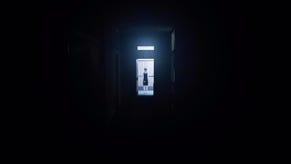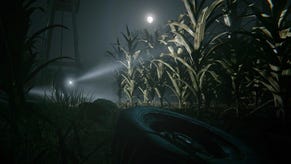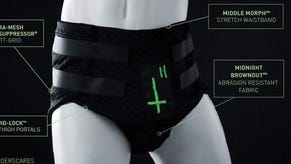Outlast 2: one last hurrah for Unreal Engine 3?
1080p60 on Xbox One and PlayStation 4, but what about PS4 Pro?
UPDATE 4/5/17 17:00: Red Barrels helpfully offers a full breakdown on its Steam page of each console's resolution limits, confirming the game does indeed use dynamic resolution. To clarify, this means sparing drops to 936p on PS4 and Xbox One, down from a typical 1080p. On the other hand, PS4 Pro drops to 1260p at the very lowest while in its 4K output mode, but generally holds at 1440p.
According to a response to this article, the studio also expands on the PS4 Pro situation at 1080p. Regular 1080p users don't leave empty-handed on PS4 Pro; as a trade-off for the absence of downsampling, you can expect improved 8x anisotropic filtering, broader draw distances, and a doubling in shadow resolution quality. According to this follow-up, it states this has "a better impact on the final image than 4K downsamping" overall. An extra advantage of this mode is there's no dynamic resolution, fixing the pixel count at 1080p.
Original story: The original Outlast championed stealth-based gameplay with some of the most graphic cutscenes this side of Resident Evil 7 - and the same template is in place with this new sequel. In Outlast 2, you're armed only with a camera to take footage, or enter a night-vision mode to see in the dark. You can't use any weapons at all and instead, running and hiding is your best defense from the twisted goings-on in the Arizona swampland. Technically speaking, the game builds on the same Unreal Engine 3 foundation as the first Outlast, but it really goes to town with some gorgeous character models, physically-based lit backdrops, and post-effects that helps simulate that all-important found-footage visual style.
There's not much to divide the console versions of the game - though for the record, the metrics tally up at a native 1080p for both PS4 and Xbox One, while the PS4 Pro gets a 78 per cent resolution bump, giving us a straight 1440p when running with 4K output enabled. Frustratingly though, if your Pro is coupled with a 1080p screen, there's no support for down-sampling - based on our pixel counts, full HD is all you get. Generally though, both PS4 and Xbox One hand in great image quality anyway at 1080p, and Outlast's heavy post-effect pipeline creates a soft, filmic look on all machines. By extension, resolution isn't the most important aspect of image quality in this title.
Visually speaking, the developer promised a few other extras on PS4 Pro , pointing to higher shadow quality, improved texture filtering and more detailed meshes. In reality though, many of these improvements are small to the point of invisibility next to the game running on a regular PS4 or Xbox One. So much of the game's details are obscured by heavy darkness and film grain that when you do get a good close-up, the improvements to shadow quality are barely recognisable. Texture filtering gets a visible boost in some scenarios though. Between PS4 and Xbox One meanwhile, there's really nothing obvious to split the two - motion blur sample quality and shadows are identical. We even checked for dynamic resolution, but from all the stress points we've tried, 1080p is a consistent result from our tests.
Resolution is something of a red herring though. Just like any great survival horror game, Outlast 2 makes the biggest impact when visibility falls short. The game is mostly played in the dark, and the camera is deliberately obscured by post effects. You get a depth of field filter that slowly draws in and out of focus, motion blur, and screen-space effects like raindrops that scatter across the lens - all of which forces you to navigate slowly through each area. On top of that, your camcorder's night-vision mode obscures things even further. A good chunk of the game is played this way, only enhancing the film grain, and vignetting that dulls your peripheral vision. And of course, chromatic aberration is in here too - a distortion to the edges of the screen that's pretty much a staple of the horror game genre this generation. But, like Outlast 2's other post-effects it's not available as an on-off toggle - it's all part of the experience.
So is there anything to divide these three machines otherwise? Well the battle really is between PS4 and Xbox One, where Microsft's machine suffers from a touch more tearing. Outlast 2 operates mostly at 60fps, but an adaptive v-sync is in play, so when frames do render over budget, tearing creeps into the image. It's great to see all console releases make 60fps a priority, and from the first hour of play, that's exactly where it holds. But clearly, full-screen tearing kicks in more visibly with Xbox One during cut-scenes especially.
A regular PS4 occasionally shows a small patch of torn frames at the same spots, while PS4 Pro winds up delivering 1440p with barely any hint of the issue. In all cases though, that 60fps line is closely adhered to with the only slight trade-off being a faint wobble to the image when that frame render time goes over budget. But again, with a post-process pipeline this heavy, the tearing doesn't stand out as much as it could have in a brighter, more vivid game. It's also rare enough that it shouldn't be an issue for Xbox One users.
All in all, Outlast 2 makes a very accomplished use of Unreal Engine 3. Yes, it's older tech now, but games like Batman Arkham Knight, or even Guilty Gear Xrd show it's still a very capable, versatile engine - especially when custom-tailored to a specific look. For Outlast 2, so much is obscured or out of view to ramp up the fear factor, specific limitations the engine may have aren't really an issue. And crucially that means 60fps and high resolutions are on the table for all machines, which definitely does improve the experience.
The only thing really missing? Well, Resident Evil 7 demonstrated just how effective virtual reality is with this genre, and support in Outlast 2 would have been the icing on the cake. Red Barrels itself believes that the title needs to be built from the ground up to get the best out of VR, so a future upgrade also seems unlikely.
But as things stand, the news is only good - from a console perspective, you can't really go wrong with any version of Outlast 2. PS4, Pro and Xbox One all deliver the goods where it matters.










